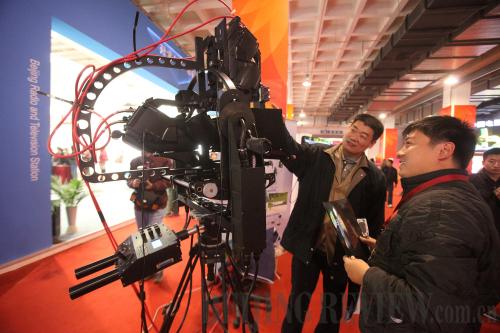|
 |
|
TECHNOLOGY FOR CREATIVE ART: Staff at the ICCIE demonstrate a vision controller used to shoot 3-D movies (WANG DAN) |
In recent years, China's cultural industry has been growing at an average annual rate of more than 17 percent, making greater contributions to the national economy. It has become a new economic growth engine.
The international financial crisis has not dampened the growth of China's cultural industry. The industry has played a special role in boosting domestic demand and adjusting the economic structure.
In 2009, the State Council released the Plan to Adjust and Reinvigorate the Cultural Industry, the first national plan in China dedicated to the cultural industry development.
To ease the financing difficulty faced by the cultural industry, this year, nine government ministries jointly issued a guiding opinion on financial support for the rejuvenation and prosperity of the cultural industry.
China's macroeconomic condition is also conducive to the development of the industry. Data from 17 major countries and regions demonstrate when a country's per-capita GDP exceeded $3,000, cultural demand rises sharply, and consumption on cultural products will surpass $615 billion.
China's per-capita GDP reached $3,700 in 2009, and consumption on cultural products only totaled $125 billion.
China's cultural industry currently accounts for 2.5 percent of the GDP. Regional cultural industry is also growing robustly. In places like Guangdong Province, Beijing and Shanghai, the cultural industry accounts for 5-7 percent of the local GDP.
Data from this ICCIE shows the cultural and creative industry created an added-value of 80.4 billion yuan ($12 billion) for Beijing in the first half of 2010, growing 15.7 percent over the same period of last year. The cultural and creative industry accounted for 12.6 percent of the capital city's GDP. Among Beijing's tertiary industries, the cultural industry was second only to the financial industry. Moreover, the current trend suggests that it is possible for the cultural industry to overtake the financial industry to become the largest tertiary industry in Beijing.
The prospect
Experts participating in the ICCIE agreed China's cultural industry is poised to maintain high growth during the next five years.
While the industry's past growth was more government-driven, in the next few years, its growth will be more market-driven, said industry experts.
Previously, China's economy relied on investment and exports, and domestic consumption was not strong. In the next five to 10 years, as the economic structure is adjusted, the government will encourage consumption.
Analysis based on data released at this year's ICCIE suggests the following trends for the industry.
First, the cultural industry will gradually become a pillar industry in the regional and national economy, given the favorable policy and economic environment the industry enjoys. It will also become a key investment area for the capital market. A batch of flagship public-listed cultural enterprises will appear. The industry will become more and more concentrated.
Second, the cultural industry will be further commercialized. Strong demand for cultural products will bring unprecedented prosperity to the industry. Investment in the industry will gradually diversify as the share of private and foreign capital increases.
Third, China's cultural brands and products will compete in the international cultural market. But, although China's export of cultural content products will gradually expand, it is still difficult to eliminate China's deficit in cultural trade.
Fourth, the cultural industry will further integrate with other industries. Convergence between the cultural, manufacturing and service industries will spur the development of these industries.
Fifth, significant progress has been made in the integration of telecommunications networks, cable TV networks and the Internet. The cultural industry is also marked by rapid digitalization, which will be the core of the cultural industry.
The author is a columnist for People's Daily online | 